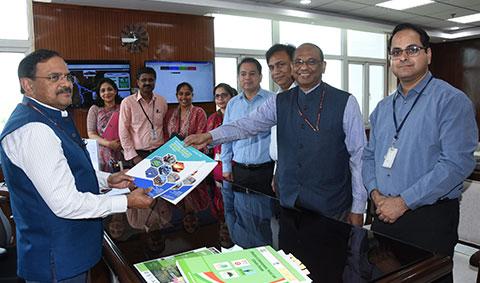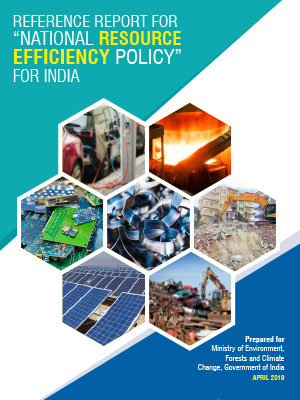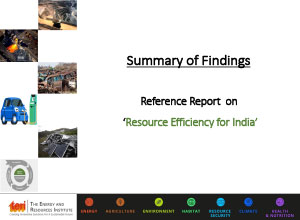TERI prepares roadmap to foster Resource Efficiency policy for India

TERI submitted a detailed reference report on 'National Resource Efficiency Policy for India' to MoEF&CC
- Improving use of resources, through adoption of a Resource Efficiency strategy, will be key to India's sustained high growth and enhanced wellbeing
- Material consumption in India has increased by more than six times - from 1.18 billion tonnes in 1970 to more than 7 billion tonnes in 2017
- The rate of recycling in India is at 20-25% as compared to developed countries like Europe
- India's average material cost in total production cost is estimated at more than 70% vis-à-vis 40 to 50% in developed economies
- Following the 6R principle, India's import dependence in steel and aluminium scrap could be brought down to zero by 2025
- It could also save 21 million tonnes of iron ore, 8.25 million tonnes of import of coking coal, 3.75 million tonnes of limestone, 4.5 million tonnes of slag generation and 31.5 million tonnes of carbon dioxide
New Delhi, April 12, 2019: The Energy and Resources Institute (TERI), a leading think tank in energy and environment, submitted a reference report on 'National Resource Efficiency Policy for India' to the Ministry of Environment, & Forests and Climate Change (MoEF&CC), Govt. of India, today.
The report talks of the need for an Integrated Resource Efficiency Approach, which is an ideal strategy towards realising the larger goal of a circular economy. This is based on the 6R (Reduce, Reuse, Recycle, Redesign, Remanufacture, Refurbish) principle that optimises material consumption at every stage of the value chain.
Enhancing Resource Efficiency and promoting the use of secondary raw materials (SRM) has emerged as a strategy for ensuring that the potential trade-off between growth and environmental well-being can be minimised. This strategy has the potential to stabilise raw material supply for industry, reduce pressures on the ecosystem, and create many green jobs.
TERI prepared the report as a knowledge partner to the Resource Efficiency Cell at the MoEF&CC. The report outlines the framework for fostering Resource Efficiency in India.
On Friday, Dr Ajay Mathur, Director General, TERI, presented the report to CK Mishra, Secretary, MoEF&CC, in the presence of Anil Kumar Jain, Additional Secretary, Government of India; Kushal Vashist, Director, MoEF&CC, and Dr Bhawna Singh, Scientist D, MoEF&CC, among others.
"It is essential that resource efficiency is embedded in our development paradigm and we move toward an economy that promotes productive use of resources across value chains in different sectors. This reference document prepared by TERI will be useful towards devising an integrated Resource Efficiency Policy for India," Mr Mishra said on the occasion.
"Given its current pattern of material consumption, India may in the near future not have access to virgin resources for driving its economy. It has to move towards a systemic approach towards resource efficiency, so that it needs less virgin material, it has to mine less resources, it is able to reduce its heavy dependency on imported scraps (e.g Aluminium) and it recycles and upcycles waste at a much larger scale," said Dr Mathur.
According to the reference report, by 2025, India would be able to generate more than 15 to 20 million tonnes of steel scrap from the automotive sector, which is more than the current scrap imported by India. Use of 6R principle could take India's import dependency in steel and aluminium scrap down to zero.
It could also save 21 million tonnes of iron ore, 8.25 million tonnes of import of coking coal, 3.75 million tonnes of limestone, 4.5 million tonnes of slag generation and 31.5 million tonnes of carbon dioxide.
On specific focus areas, the report suggests the following action areas towards implementing a resource efficiency policy: -
- Regulatory gaps to foster resource efficient and circular design - enhanced implementation of waste management laws, quality standards for the use of secondary materials, certification of circular products, resource efficient packaging, strengthen environmental liability and integrate lifecycle thinking
- Design of innovative market-based instruments - inclusion of provisions for procurement of resource efficient products and eco-labelled products in public procurement through green procurement guidelines, training workshop for procurement staff, circular procurement through take-back options and third-party arrangements; public tenders to include resource efficiency related quotas and bonus points
- Creation of resource efficient business models - government support through direct subsidies, viability gap funding, mandatory public procurement, networking and dissemination of solutions as well as regulation to accelerate adoption of certain technologies and/or practices.
- Integrating the informal sector with the formal sector - Aid the informal sector's access to technology and funding for improving their operations, ensuring safe and healthy working environment for those employed in the sector; help create GIS-based platforms for resource recovery and recycling, providing access to requisite technology and providing skill development to use this technology , organise cooperatives, public private partnerships
- Strengthening research and knowledge data base - R&D to improve process efficiency and to introduce new processes, improve the recyclability and resource recovery potential of materials at the end of life, finding substitutes and developing sound methodologies to carry out inventorisation and characterization of major waste streams
Souvik Bhattacharjya, Fellow, TERI, who is among the authors of the report, added, "The absence of lifecycle thinking at the policy level often impedes exploring inter-linkages that can make India utilise resources more efficiently and unlock the associated benefits. An integrated approach that brings together people, technology and processes, and that is facilitated through a suitable policy cutting across materials and sectors will bring in the desired transition towards high resource efficiency."
About TERI
The Energy and Resources Institute (TERI) is an independent, multi-dimensional organisation, with capabilities in research, policy, consultancy and implementation. It has pioneered conversations and action in the energy, environment, climate change, and sustainability space for over four decades.
The institute's research and research-based solutions have had a transformative impact on industry and communities. Headquartered in New Delhi, it has regional centres and campuses in Gurugram, Bengaluru, Guwahati, Mumbai, Panaji, and Nainital, supported by a multidisciplinary team of scientists, sociologists, economists and engineers, and state-of-the-art infrastructure.
For further information, contact:
TERI:
Pallavi Singh: pallavi.singh@teri.res.in
Aastha Manocha: aastha.manocha@teri.res.in
Edelman:
Mehak Arora: Mehak.arora@edelman.com


